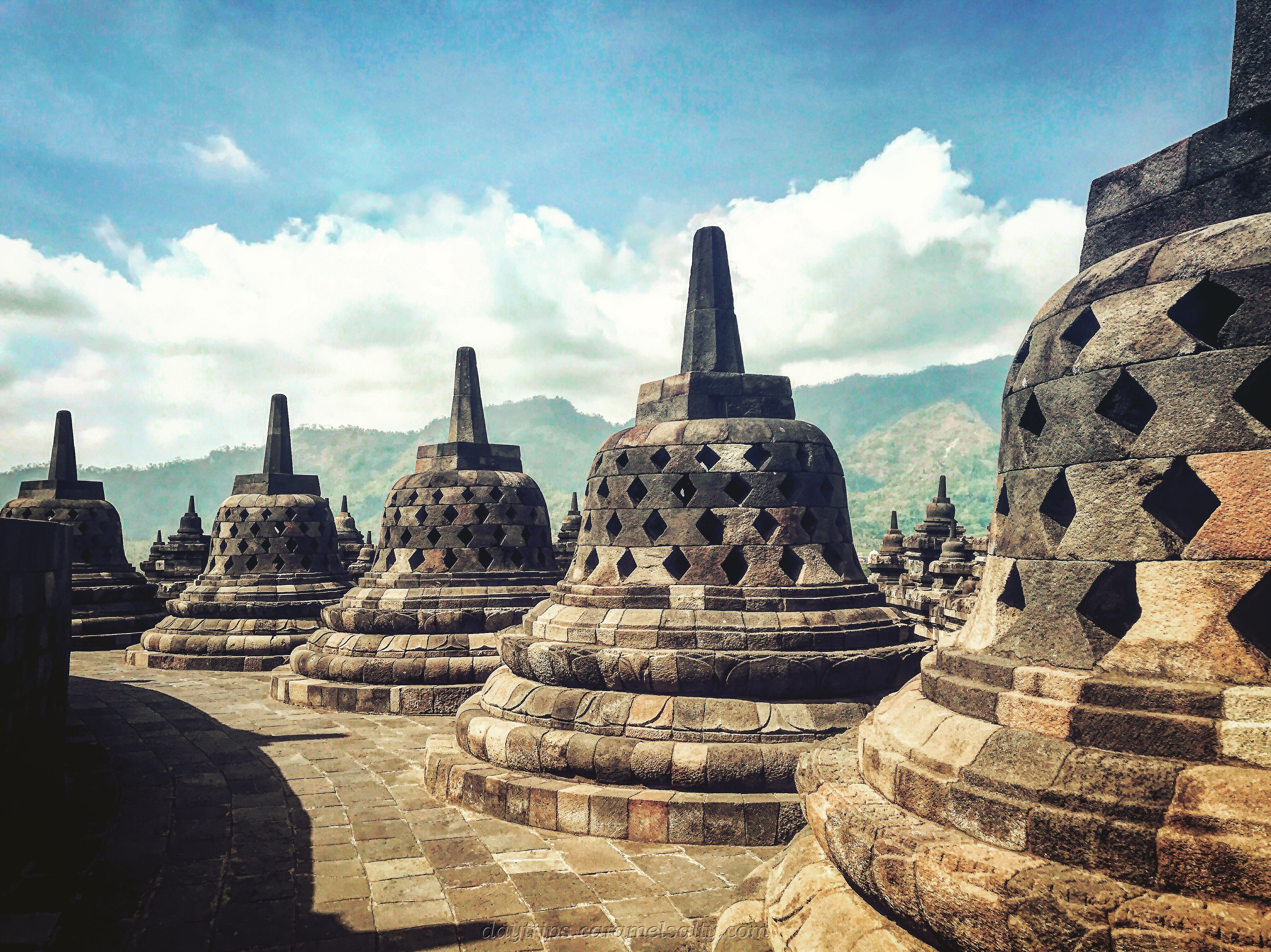
Jogjakarta
Jogjakarta (Jogja)
Many people, and travel sites, say you only need 2 days in Jogja. But I stayed for 4 days and was never bored for a second. This is what I got up to.
Getting to your hotel from the airport by public transport
Transjogja operates an air conditioned service all round Jogja, 05:30 to 21:30 daily. There is a bus terminal at the airport (10 min walk). Turn right outside the airport com plex and on reaching a modern food court, enter the complex and locate the subway that takes you under the railway tracks. On exiting the subway turn left and head for a portakabin (the bus stop) in, what appears to be, a car park. The bus stop managers will get you on the right bus and let the bus attendants know your destination. Whilst it can get busy at peak hours, it’s clean and cheap. Fares are a standard 3500 IDR per destination, even if you use multiple buses.
plex and on reaching a modern food court, enter the complex and locate the subway that takes you under the railway tracks. On exiting the subway turn left and head for a portakabin (the bus stop) in, what appears to be, a car park. The bus stop managers will get you on the right bus and let the bus attendants know your destination. Whilst it can get busy at peak hours, it’s clean and cheap. Fares are a standard 3500 IDR per destination, even if you use multiple buses.
I stayed in a hotel half way down Jalan Malioboro. Location was convenient for shopping, visiting sights, eateries and the train station.
Day 1 Afternoon – Prambanan
Prambanan Temple ⭐️⭐️⭐️⭐️⭐️[Opening Hours: 0600 -1730]
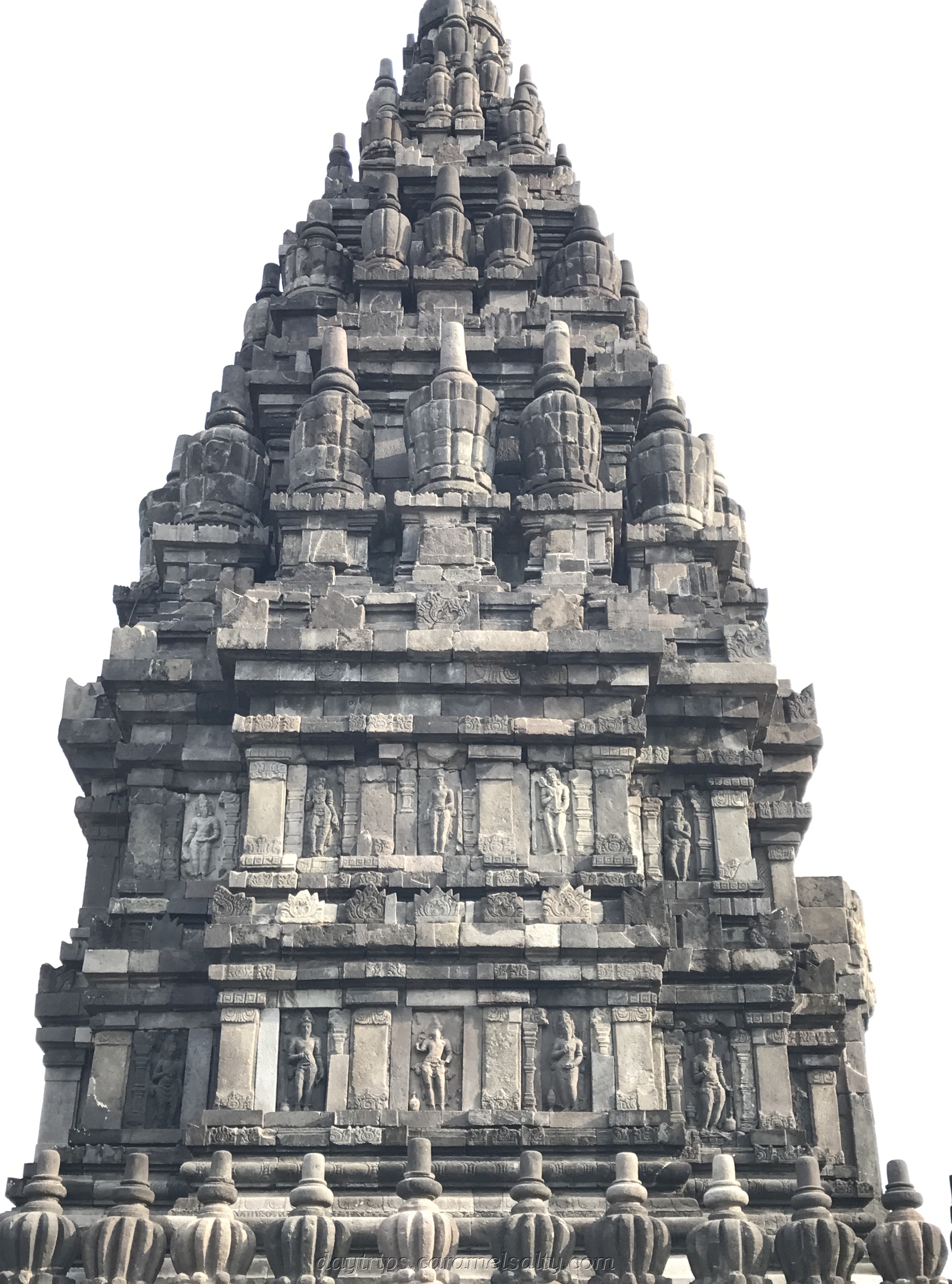 Also known as Candi Rara Jonggrang, this 9th century ancient Hindu Temple, was built by the Mataram Dynasty, rulers of Central Java and defeaters of the Sailendra Dynasty. The sharp jagged towers of the Hindu temples are a contrast to the square pyramid structure of Borobudur. It’s a UNESCO World Heritage Site, being one of the largest Hindu temple architecture in South East Asia. It
Also known as Candi Rara Jonggrang, this 9th century ancient Hindu Temple, was built by the Mataram Dynasty, rulers of Central Java and defeaters of the Sailendra Dynasty. The sharp jagged towers of the Hindu temples are a contrast to the square pyramid structure of Borobudur. It’s a UNESCO World Heritage Site, being one of the largest Hindu temple architecture in South East Asia. It 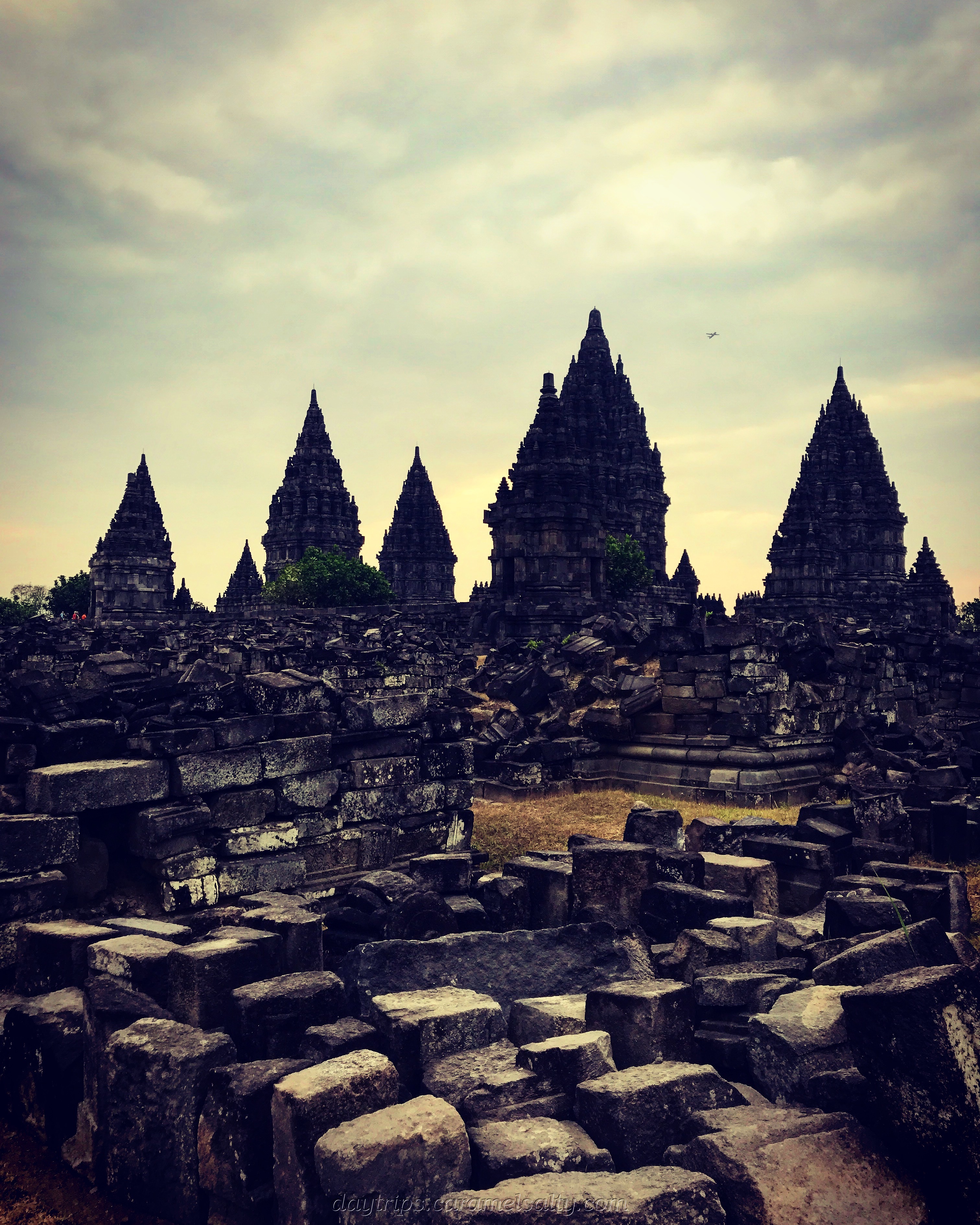 was abandoned in the 10th century for reasons not clear. It was during the brief occupation of the British of Dutch East Indies in 1811, that the Temple was discovered by accident. An earthquake in 2006, destroyed much of the temple, which is why there are many stones and carvings scattered around. Wikitravel has an interesting write up about the Temple, as well as the legend of Long Jonggrang. Wikipedia has a good map of the temple complex.
was abandoned in the 10th century for reasons not clear. It was during the brief occupation of the British of Dutch East Indies in 1811, that the Temple was discovered by accident. An earthquake in 2006, destroyed much of the temple, which is why there are many stones and carvings scattered around. Wikitravel has an interesting write up about the Temple, as well as the legend of Long Jonggrang. Wikipedia has a good map of the temple complex.
Tips: I would recommend visiting the main complex either first thing in the morning, or stay till sunset. Crowds are thinner and the light is better for photos at these times. You can also purchase a combined Prambanan and Borobodur ticket which is valid for 2 days, and is slightly cheaper than two separate tickets. It cost me Rp 550,000 (Sep 2017) for the combined ticket.
Transjogja Bus 1A will get you there (30 mins from Jogja). It’s terminal is at Prambanan, at a market right by the Yogyakarta-Solo highway. Cross the highway at the lights and you’ll come upon a fenced, quiet area with lots of trees. That is the Prambanan temple complex. Walk right further up the road, past the ancient-looking arches, to get to the entrance by the car park.
Borobodur Park manage both the Prambanan and Borobodur sights. Check their website for special events.
Ramayana Dance, Prambanan ⭐️⭐️⭐️⭐️⭐️[Show Time: 19:30-21:30]
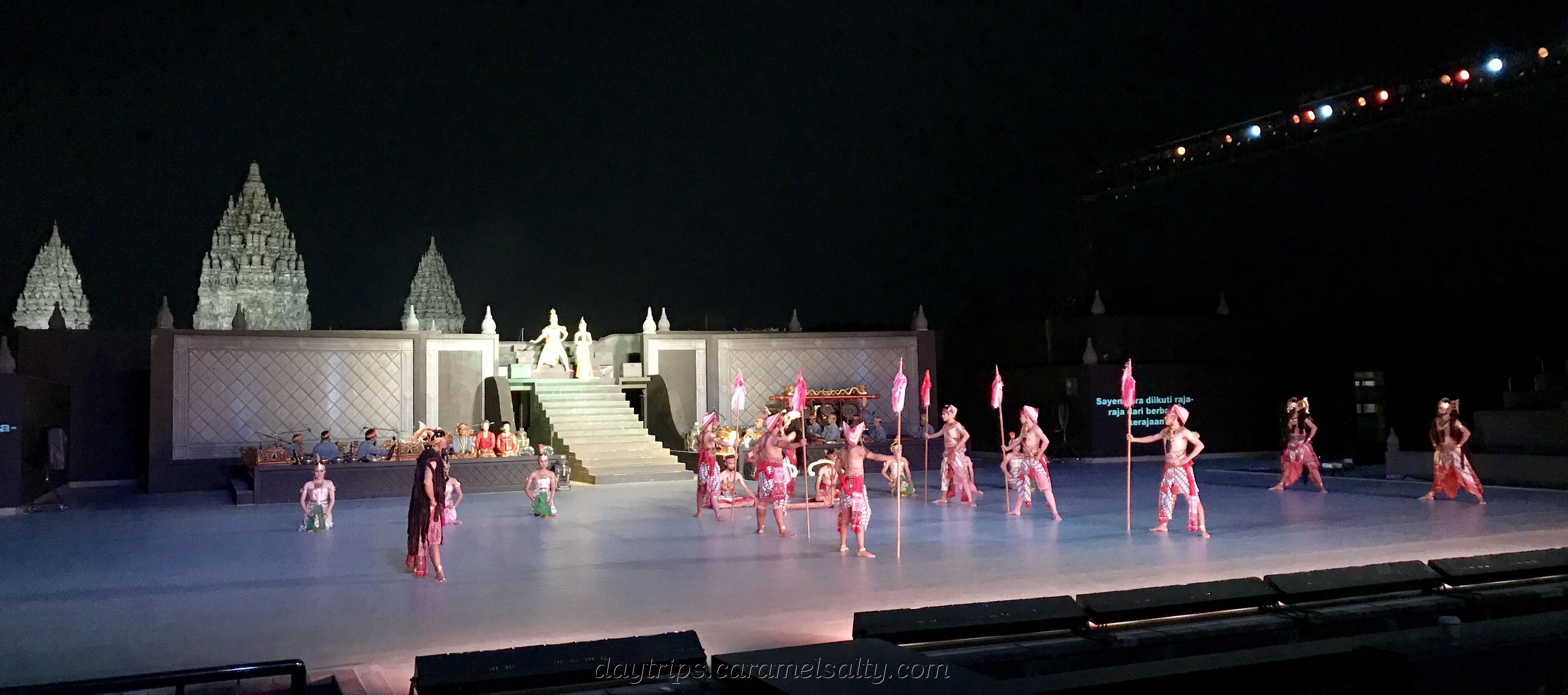 Is performed outdoors from May to November (indoors otherwise) and is worth watching for the performance, the story line (which is narrated on screen) and the setting of the open air theatre against the backdrop of the lit up Prambanan. The performance involves 150 artisans, dancers and gamelan musicians, and is only performed every Tuesday, Thursday and Saturday night. Visit Ramayana Show for details of the show and to reserve your tickets via email correspondence. You pay at the ticket counter on arrival.
Is performed outdoors from May to November (indoors otherwise) and is worth watching for the performance, the story line (which is narrated on screen) and the setting of the open air theatre against the backdrop of the lit up Prambanan. The performance involves 150 artisans, dancers and gamelan musicians, and is only performed every Tuesday, Thursday and Saturday night. Visit Ramayana Show for details of the show and to reserve your tickets via email correspondence. You pay at the ticket counter on arrival.
Tips: 1. If you do stay on in Prambanan until closing time, then simply explain that you are watching the performance. You are then allowed to wander through the outer complex to the theatre, at close proximity to the temples which are lit up just after dusk. Useful to also have a torch on you as you wander around in the dark.
2. There is a Garden Resto restaurant located right next to the open air stage, which only serves an Indonesian buffet at over Rp 100,000 per pax. For a cheaper alternative, walk back to the main road (10 minutes) and turn right for a Supermart where you can grab snacks and drinks, which, you could even take in to the show. I also spotted a freshly made egg murtabak (bread) street stall en route.
3. You are able to prebook a taxi back with the organisers of the show at Rp 20,000 per pax. Consider using Grab or checking how much a taxi on the street would cost before going in to the complex.
4. Go for the Class1 or Class 2 seats. The cheap seats are sideways on which means you don’t get a view of Prambanan as the backdrop. And you don’t get cushions in the cheap seats. Just a stone bench.
Day 2 – Borobudur and Mageleng
Borobudur ⭐️⭐️⭐️⭐️⭐️ [Opening Hours: 06:00 -17:00]
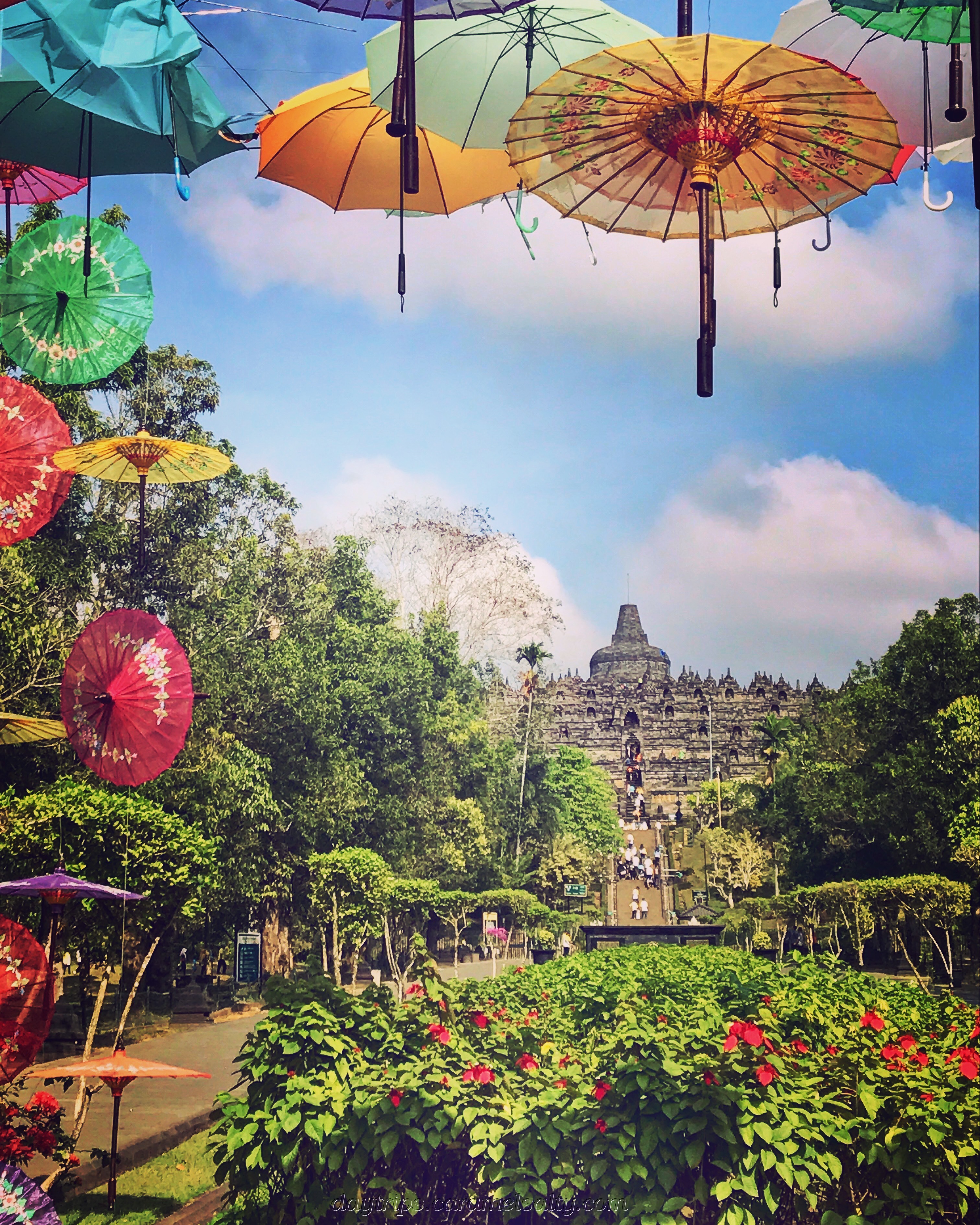 The Sailendra dynasty, who ruled Central Java at the time, built this largest Buddhist monument in the world between AD 780 and 840. It was built as a place for glorifying Buddha and a pilgrimage spot. This UNESCO Heritage site consists of six square platforms with 2,672 relief panels and 504 Buddha statues.
The Sailendra dynasty, who ruled Central Java at the time, built this largest Buddhist monument in the world between AD 780 and 840. It was built as a place for glorifying Buddha and a pilgrimage spot. This UNESCO Heritage site consists of six square platforms with 2,672 relief panels and 504 Buddha statues.
The centuries that followed saw a shift of power to the East of the country and the arrival of Islam on Java Island. By the 16th century Borobudur had been mysteriously abandoned. It lay hidden under 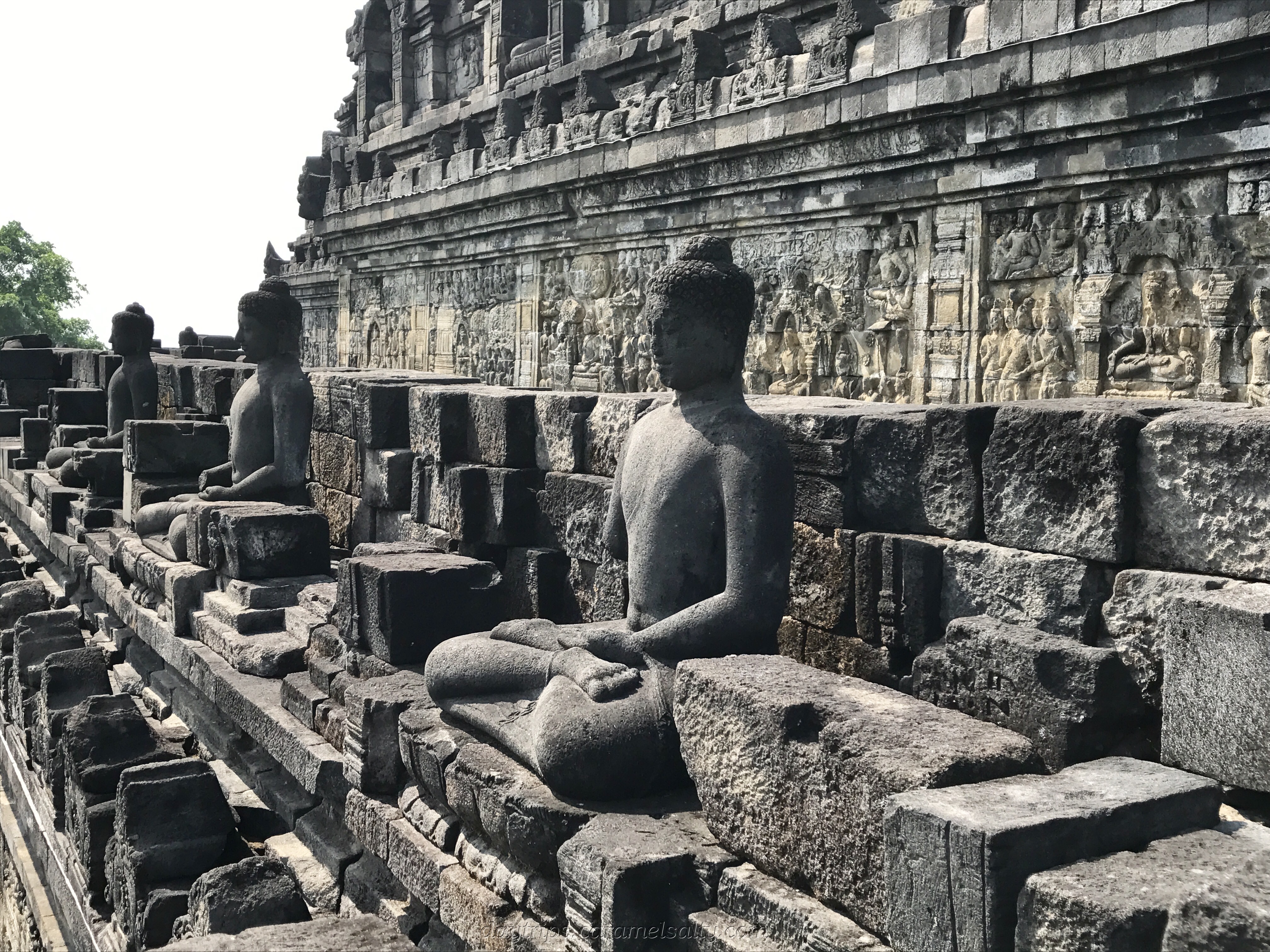 layers of volcanic ash & jungle growth for centuries, until it’s discovery in 1814 by General Stamford Raffles, who had a great interest in history. It took his men 2 months to clear the jungle to locate the temple.
layers of volcanic ash & jungle growth for centuries, until it’s discovery in 1814 by General Stamford Raffles, who had a great interest in history. It took his men 2 months to clear the jungle to locate the temple.
Get there as early as possible, as it does get extremely hot. Even by public transport, you could get there from Jogjakarta by 07:30. Again,  do read Wikitravel’s entry and the wonderful map in Wikipedia (and take a photo of it so that it’s to hand). I would recommend working your way up gradually by circling each level. Save the stupas and the views for last. I sat on a ledge at the top platform to take in the views of the mountains and the verdant plains of Kedu.
do read Wikitravel’s entry and the wonderful map in Wikipedia (and take a photo of it so that it’s to hand). I would recommend working your way up gradually by circling each level. Save the stupas and the views for last. I sat on a ledge at the top platform to take in the views of the mountains and the verdant plains of Kedu.
Regular buses to Borobudur (60 minute journey) leave from Yogyakarta’s Terminal Jombor (opening hours 05:30 to 21:30), and charge Rp 25,000. Jombor terminal is serviced by several Transjogja buses. Get to your nearest bus stop and ask. Please note that Jalan Malioboro is a one way road going south. Jombor is north of the city, so walk across to Jalan Pelajar ( parallel road to the west of Jalan Malioboro) for the quickest route to Jombor.
Once on the road, you will be rewarded with paddy field scenery past Magilan. From the Borobodur termina
the road, you will be rewarded with paddy field scenery past Magilan. From the Borobodur termina l, cut through the food stalls (where I had breakfast) towards the market. Turn left on the main road by the local market, and Borobodur is about a 10 minute walk from there. Be advised that the last return bus to Yogyakarta is at 15.00. You can still catch a bus to Mageleng and return to Jogja from Magelang until evening.
l, cut through the food stalls (where I had breakfast) towards the market. Turn left on the main road by the local market, and Borobodur is about a 10 minute walk from there. Be advised that the last return bus to Yogyakarta is at 15.00. You can still catch a bus to Mageleng and return to Jogja from Magelang until evening.
You will be routed through the north exit on the way out. There is a small ship museum on the way out. It’s nothing special. However there is a replica of an 8th century Borobodur sailing ship which is worth seeing.
Mageleng
From Borobodur there are regular buses to Mageleng. I was dropped off at the Artos Plaza, where I briefly enjoyed an air conditioned food court in the mall. Then I headed to Jalan Jenderal Sudirman, and hail a shuttle bus (small vans) towards “Alun Alun” (town centre). For the OHD Museum.
OHD Museum⭐️⭐️⭐️⭐️⭐️
 If you only have time to do only one thing in Mageleng, then it has to be the OHD museum. It’s Dr Oei Hong Dijon’s private museum of modern and contemporary Indonesian art. It is beautifully curated and contains the who’s who of current Indonesian artistes. I was also invited to visit Lapangan Kwarasan, the home of Dr Oei Hong Dijon, which also serves as an exhibition space. I
If you only have time to do only one thing in Mageleng, then it has to be the OHD museum. It’s Dr Oei Hong Dijon’s private museum of modern and contemporary Indonesian art. It is beautifully curated and contains the who’s who of current Indonesian artistes. I was also invited to visit Lapangan Kwarasan, the home of Dr Oei Hong Dijon, which also serves as an exhibition space. I 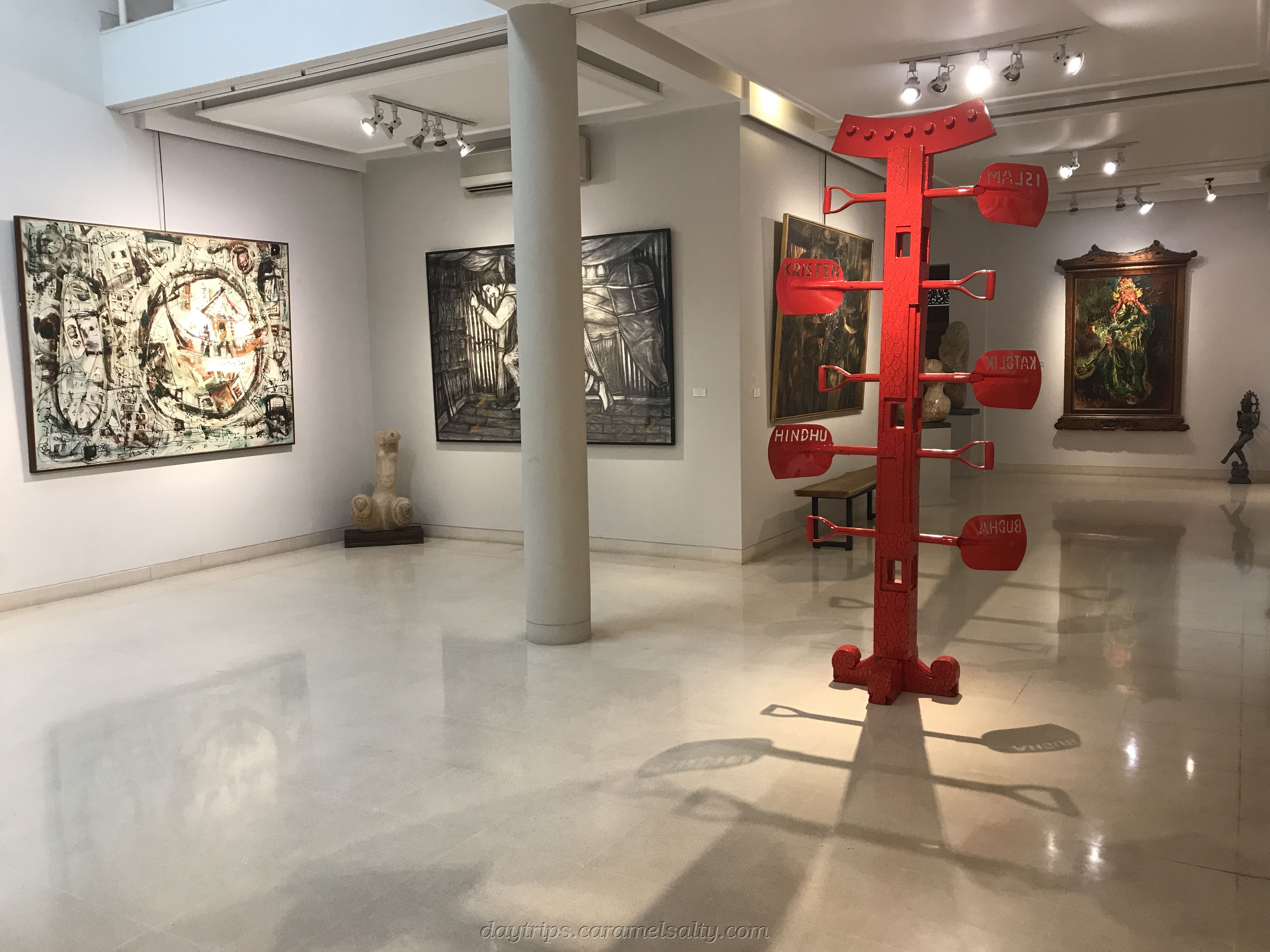 had the opportunity to meet him in p
had the opportunity to meet him in p erson. He is a great promoter of Indonesian art. If you are an art lover, then it’s a museum not to be missed whilst in Jogja.
erson. He is a great promoter of Indonesian art. If you are an art lover, then it’s a museum not to be missed whilst in Jogja.
For the return journey back to Jogja, either catch a shuttle bus (or walk) to the main bus terminal for the Patas air conditioned bus back to Jogja or return to Artos Plaza for the more atmospheric non air conditioned bus. The return journey back to Jombor is about 1 hour.
Day 3 – A Really Full Day out in Jogjakarta
The direction of my walking tour is based on proximity of sights to eac h other. You may get a becak (tuktuk) for part, or all, of the tour. It may not take the whole day if you catch rides. And do look out for the becaks in Jogja, as they are all prettily decorated.
h other. You may get a becak (tuktuk) for part, or all, of the tour. It may not take the whole day if you catch rides. And do look out for the becaks in Jogja, as they are all prettily decorated.
A Dawn Walk through Kampung Jugoyudon⭐️⭐️⭐️⭐️⭐️
If you start your walk at sunrise, around 05:30, you will be rewarded with grea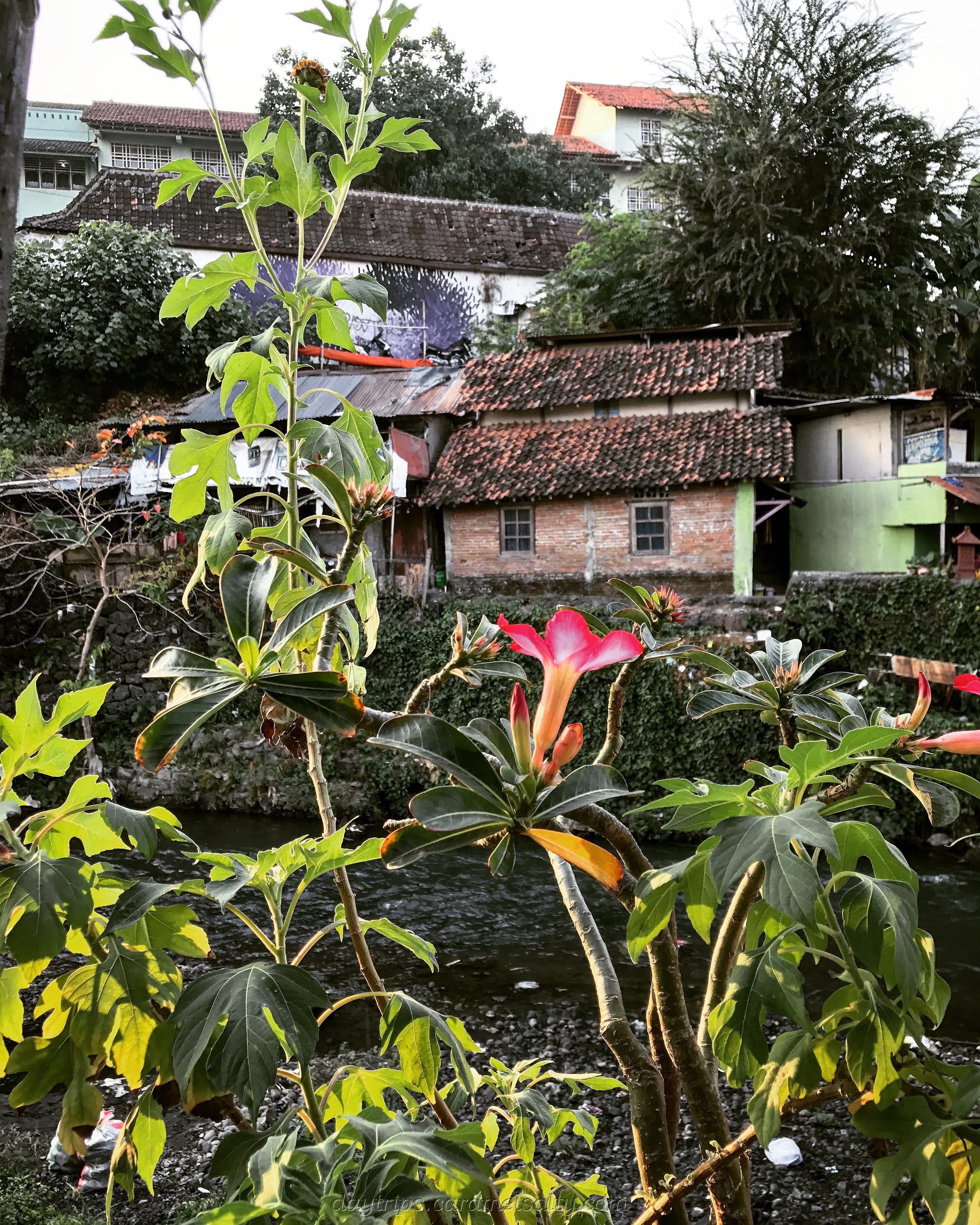 t pictures. The locals are friendly and will chat, although it will help if you know some Bahasa Indonesia. I start the walk from the train crossing by the Tugu Train Station on Jalan Malioboro. Facing south, turn left along Jalan Kleringan, which runs alongside the train line, until you reach the busy Jambatan Kewek roundabout. You need to get into th
t pictures. The locals are friendly and will chat, although it will help if you know some Bahasa Indonesia. I start the walk from the train crossing by the Tugu Train Station on Jalan Malioboro. Facing south, turn left along Jalan Kleringan, which runs alongside the train line, until you reach the busy Jambatan Kewek roundabout. You need to get into th e central section of the roundabout to look for the pedestrian underpass that takes you under the bridge to the west bank of the river. There is no set route. The point is to lose yourself in the streets of the kampung (village). And do stray away from the river, deeper into the village.
e central section of the roundabout to look for the pedestrian underpass that takes you under the bridge to the west bank of the river. There is no set route. The point is to lose yourself in the streets of the kampung (village). And do stray away from the river, deeper into the village.
The villa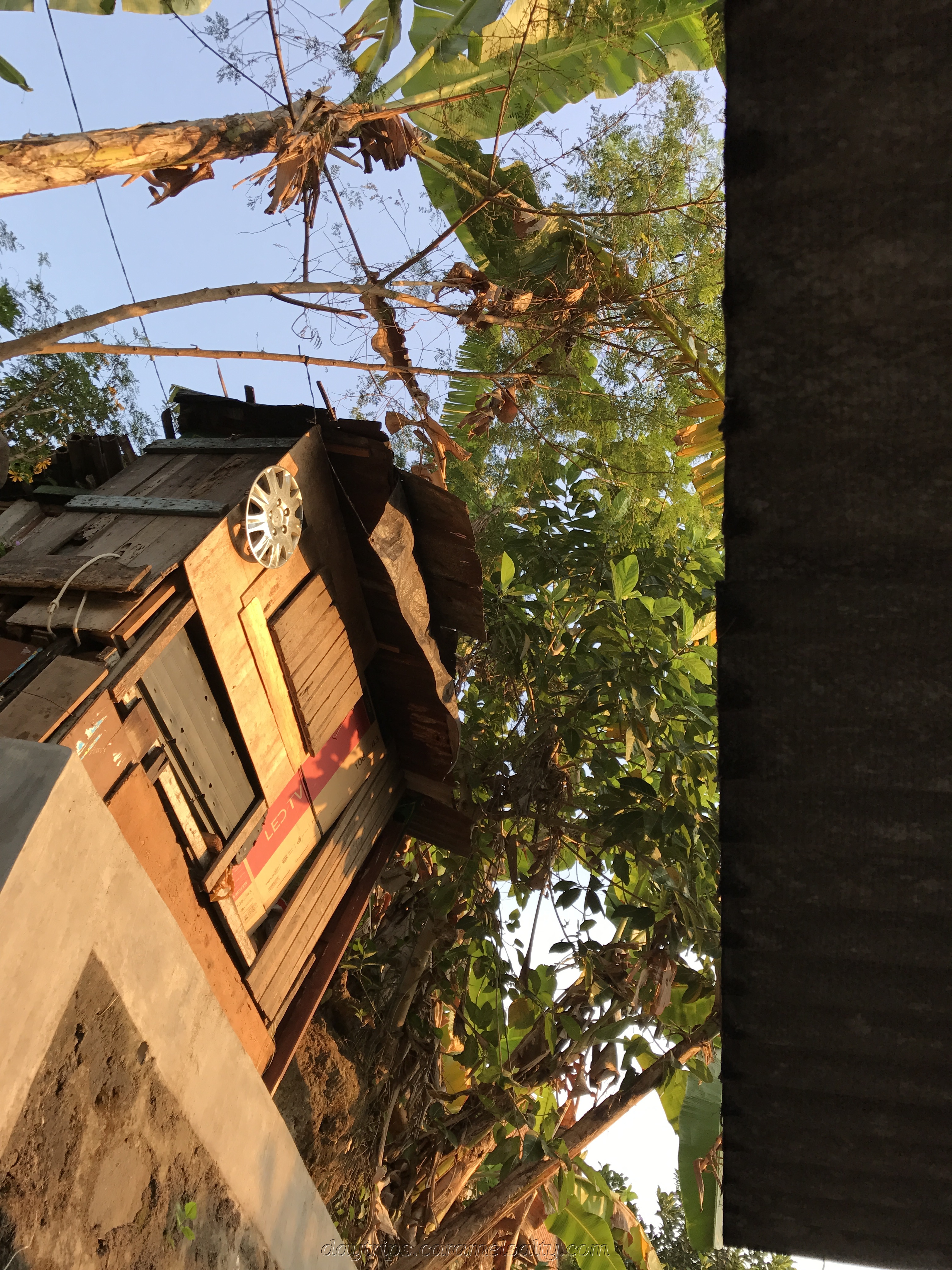 ge stirs early. There are prayers to be said, kids to shepherd to school, village shops to open up. By 06:00, you will hear the reciting of the Quran by school children being broadcast from the speakers of the religious school across the river. By the time you emerge onto Jalan Kampong Jugoyudon, and then onto Jalan Jend. Sudirman, you will be startled by the din of the traffic jam even by 06:30. Despite the proximity of this hustle and bustle above you, you hear none of this in the Kampong.
ge stirs early. There are prayers to be said, kids to shepherd to school, village shops to open up. By 06:00, you will hear the reciting of the Quran by school children being broadcast from the speakers of the religious school across the river. By the time you emerge onto Jalan Kampong Jugoyudon, and then onto Jalan Jend. Sudirman, you will be startled by the din of the traffic jam even by 06:30. Despite the proximity of this hustle and bustle above you, you hear none of this in the Kampong.
Breakfast of Soto Ayam ⭐️⭐️⭐️⭐️⭐️
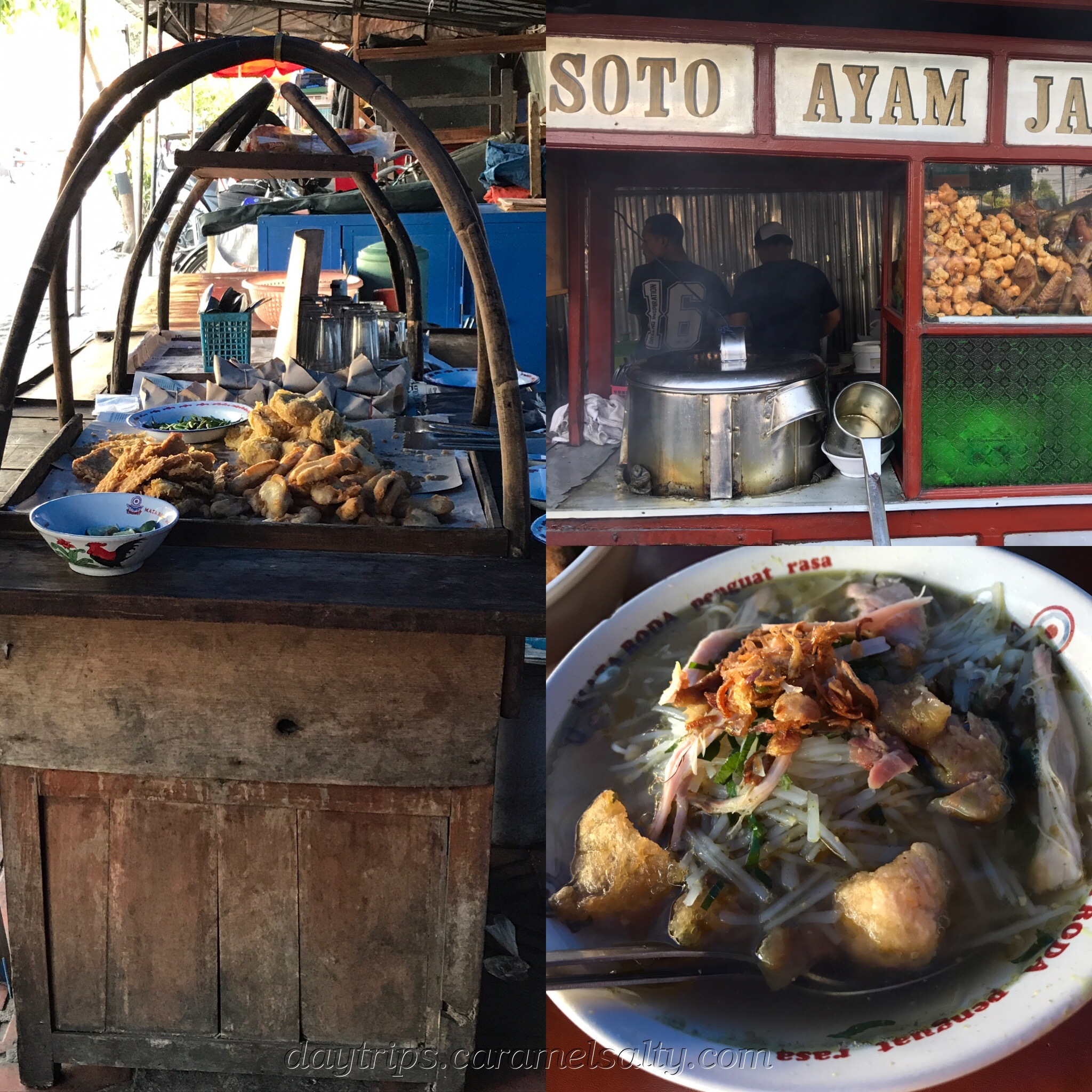 Make your way to the Tugu at the intersection of Jalan Malioboro. Turn into Jalan Malioboro. Have a Soto Ayam at a road side stall on Jalan Maliaboro, north of the train lines. Pick a stall that is popular with the locals.
Make your way to the Tugu at the intersection of Jalan Malioboro. Turn into Jalan Malioboro. Have a Soto Ayam at a road side stall on Jalan Maliaboro, north of the train lines. Pick a stall that is popular with the locals.
Museum Benteng Vredeburg ⭐️⭐️⭐️⭐️[Opening Hours:07:30 – 16:00]
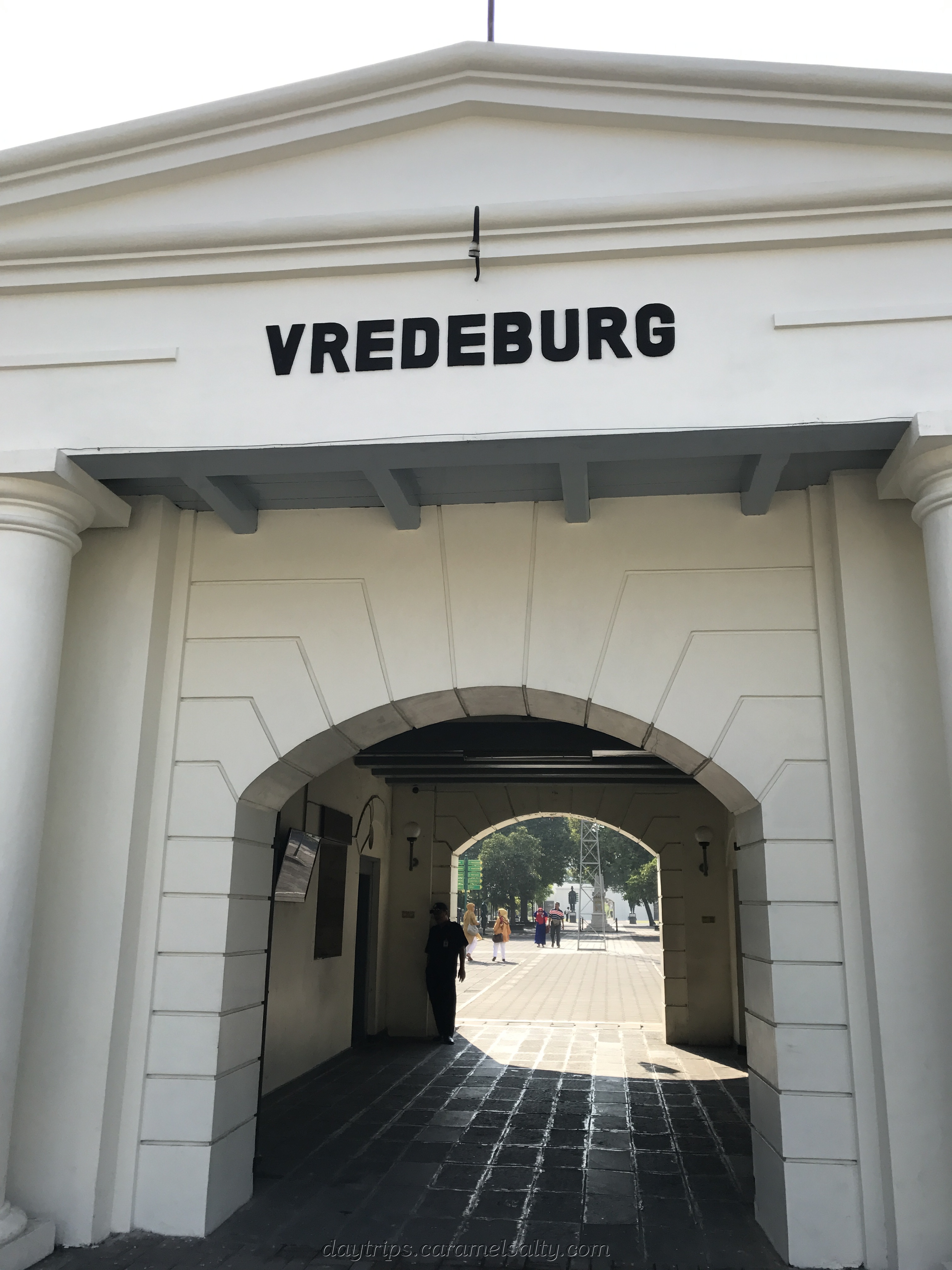 Originally a temporary Dutch wooden fort in 1760, the now fortified permanent fort was destroyed by an earthquake in 1867. The fort was rebuilt and called Fort Vredeburg, (“Peace fort” due to co-existence of the fort and the Sultan’s Kraton across the green). In 1942, it became the Japanese army’s headquarters and war prison. After the Japanese left
Originally a temporary Dutch wooden fort in 1760, the now fortified permanent fort was destroyed by an earthquake in 1867. The fort was rebuilt and called Fort Vredeburg, (“Peace fort” due to co-existence of the fort and the Sultan’s Kraton across the green). In 1942, it became the Japanese army’s headquarters and war prison. After the Japanese left in 1945, Fort Vredeburg served the Indonesian Army as military barracks and prison for suspected members of the communist party. The museum recounts the events from the Declaration of Independence by Indonesia on the 17th August 1945 and the events thereafter leading to the final departure of the Dutch in 1949. There is also a wooden Javanese cafe on site. It only opens at 10:00. Perfect for a cup of coffee for the return journey.
in 1945, Fort Vredeburg served the Indonesian Army as military barracks and prison for suspected members of the communist party. The museum recounts the events from the Declaration of Independence by Indonesia on the 17th August 1945 and the events thereafter leading to the final departure of the Dutch in 1949. There is also a wooden Javanese cafe on site. It only opens at 10:00. Perfect for a cup of coffee for the return journey.
Museum Sonobudoyo ⭐️⭐️⭐️[Opening Hours: 08:00 – 22:00]
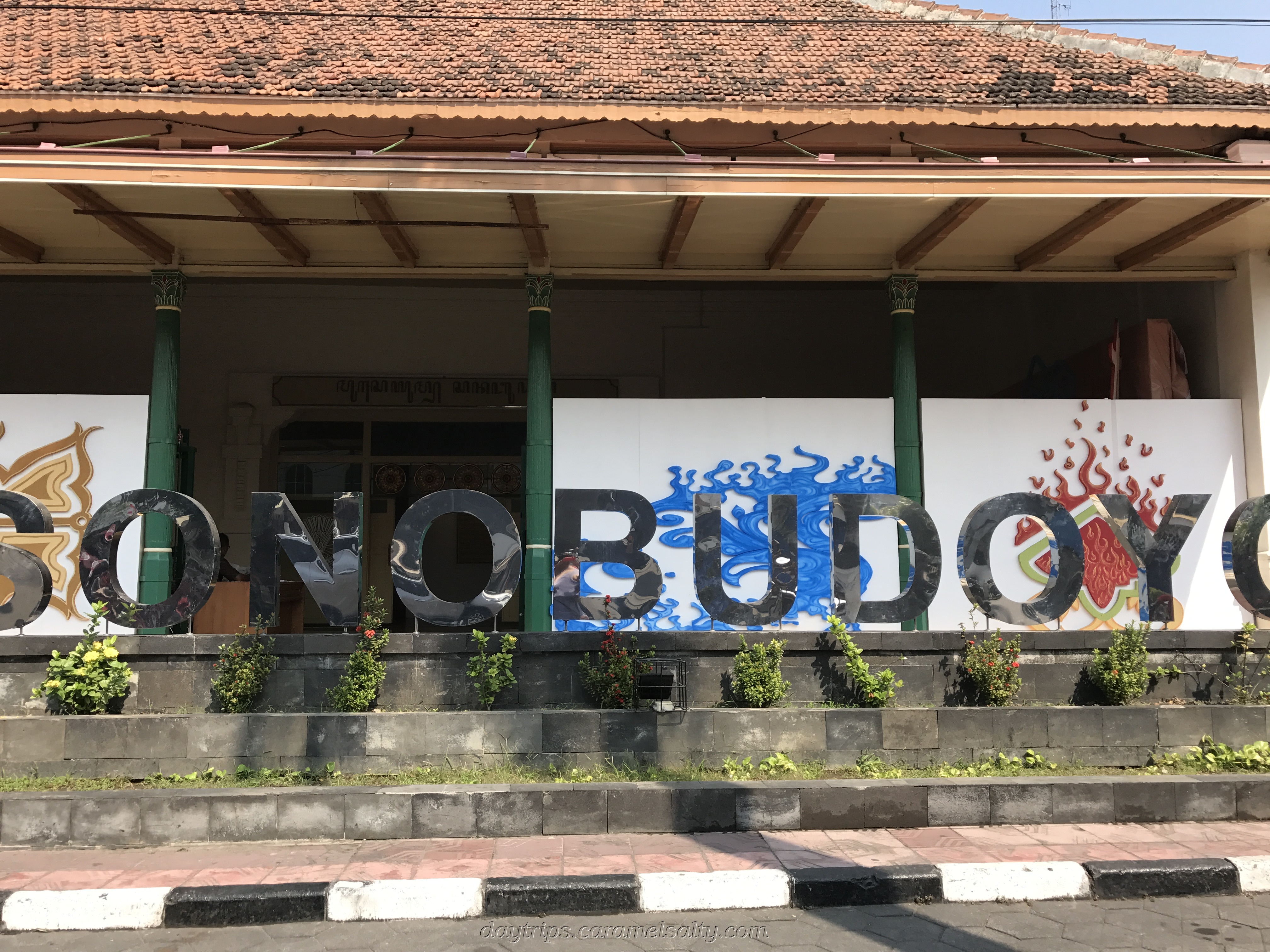 Diagonally across the set of traffic lights is the free Museum Sonobudoyo which celebrates citizens who have made significant cultural contributions. Wayang Kulit (the Javanese shadow play, accompanied by gamelan orchestra) is performed every night here. [20:00 – 22:00, Rp 20,000]. If you are keen, enquire about tickets before leaving.
Diagonally across the set of traffic lights is the free Museum Sonobudoyo which celebrates citizens who have made significant cultural contributions. Wayang Kulit (the Javanese shadow play, accompanied by gamelan orchestra) is performed every night here. [20:00 – 22:00, Rp 20,000]. If you are keen, enquire about tickets before leaving.
Kraton Yogyakarta (The Palace of Yogyakarta) [Opening Hours: 08:00 to 14:00]⭐️⭐️
 At the south of the alun alun (Javanese for the large central open lawn squares common in Indonesian villages, towns and cities). is the well-maintained palace from the days of Sultans of Yogyakarta. The Kraton is built facing directly north towards the majestic Mt. Merapi with its south backing the Indian Ocean, believed to be the abode of Kanjeng Ratu Loro Kidul, the Queen of the South Seas and the mystical consort of the Sultan. I actually found the Kraton quite disappointing. Perhaps I’d missed going through a secret door. And I felt that the guides were more interested in taking me to the Batik Museum.
At the south of the alun alun (Javanese for the large central open lawn squares common in Indonesian villages, towns and cities). is the well-maintained palace from the days of Sultans of Yogyakarta. The Kraton is built facing directly north towards the majestic Mt. Merapi with its south backing the Indian Ocean, believed to be the abode of Kanjeng Ratu Loro Kidul, the Queen of the South Seas and the mystical consort of the Sultan. I actually found the Kraton quite disappointing. Perhaps I’d missed going through a secret door. And I felt that the guides were more interested in taking me to the Batik Museum.
Keraton Batik Museum ⭐️⭐️⭐️
I was led to the batik museum by the Kraton officials. As it was en route to the next 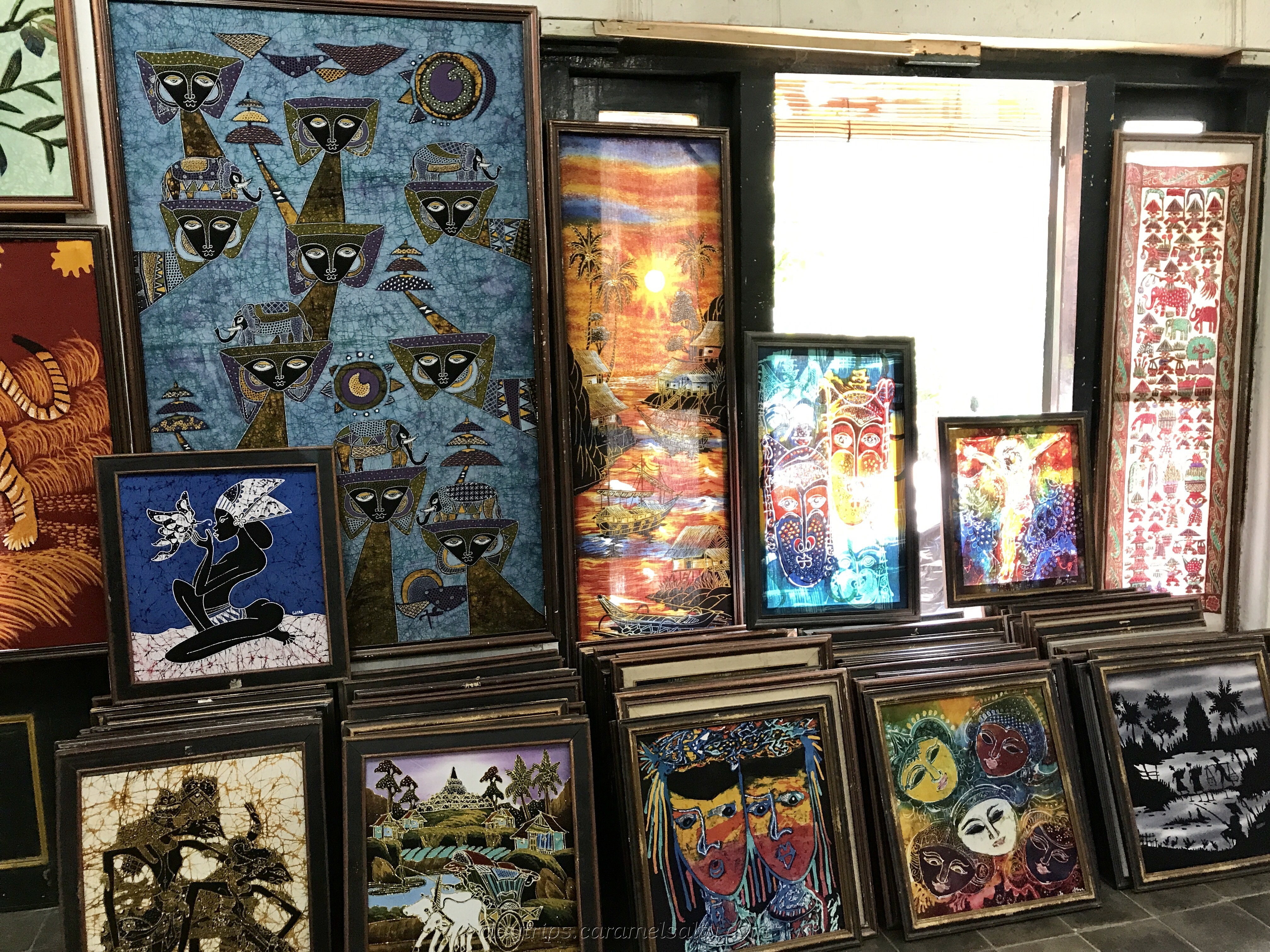 destination, I let myself be taken there. Is it a tourist trap? I couldn’t tell and didn’t have enough time to visit other “batik museums” around to compare prices. All I can say is, if you see something you love, then get it if the price is affordable. If not walk away or just admire the craftsmanship, which is superb by the way. There is no hard sell here. However the batik museum is a good little starting point for a very interesting walk to Taman Sari.
destination, I let myself be taken there. Is it a tourist trap? I couldn’t tell and didn’t have enough time to visit other “batik museums” around to compare prices. All I can say is, if you see something you love, then get it if the price is affordable. If not walk away or just admire the craftsmanship, which is superb by the way. There is no hard sell here. However the batik museum is a good little starting point for a very interesting walk to Taman Sari.
The Interesting Walk to Taman Sari⭐️⭐️⭐️
 So on exiting the Batik Factory, I head left, passing a kindergarten, following Jalan Sidokmuti around, and then turning left into an alley. Lots of neat houses and shophouses with beautiful house plants. Ordinary folks going about their ordinary business. Then out into busy Jalan Tamanan, until we get to Taman Sari.
So on exiting the Batik Factory, I head left, passing a kindergarten, following Jalan Sidokmuti around, and then turning left into an alley. Lots of neat houses and shophouses with beautiful house plants. Ordinary folks going about their ordinary business. Then out into busy Jalan Tamanan, until we get to Taman Sari.
Water Castle (Taman Sari) ⭐️⭐️⭐️⭐️⭐️[Opening Hours: 09:30 – 15:30]
The most famous place in Tamansari is the bathing and resting place of the Sultan and  his Princesses named Umbul Pasiraman. The Sultan loved hunting and The Umbul Pasiraman was designed to appease the Sultan of that desire. To catch his ‘two-legged prey’, it is said that the Sultan would throw a rose from the high tower on the south of the pool and the Princess who caught that rose would be his ‘wife’.
his Princesses named Umbul Pasiraman. The Sultan loved hunting and The Umbul Pasiraman was designed to appease the Sultan of that desire. To catch his ‘two-legged prey’, it is said that the Sultan would throw a rose from the high tower on the south of the pool and the Princess who caught that rose would be his ‘wife’.
 This castle is a huge complex that used to be a former royal palace
This castle is a huge complex that used to be a former royal palace 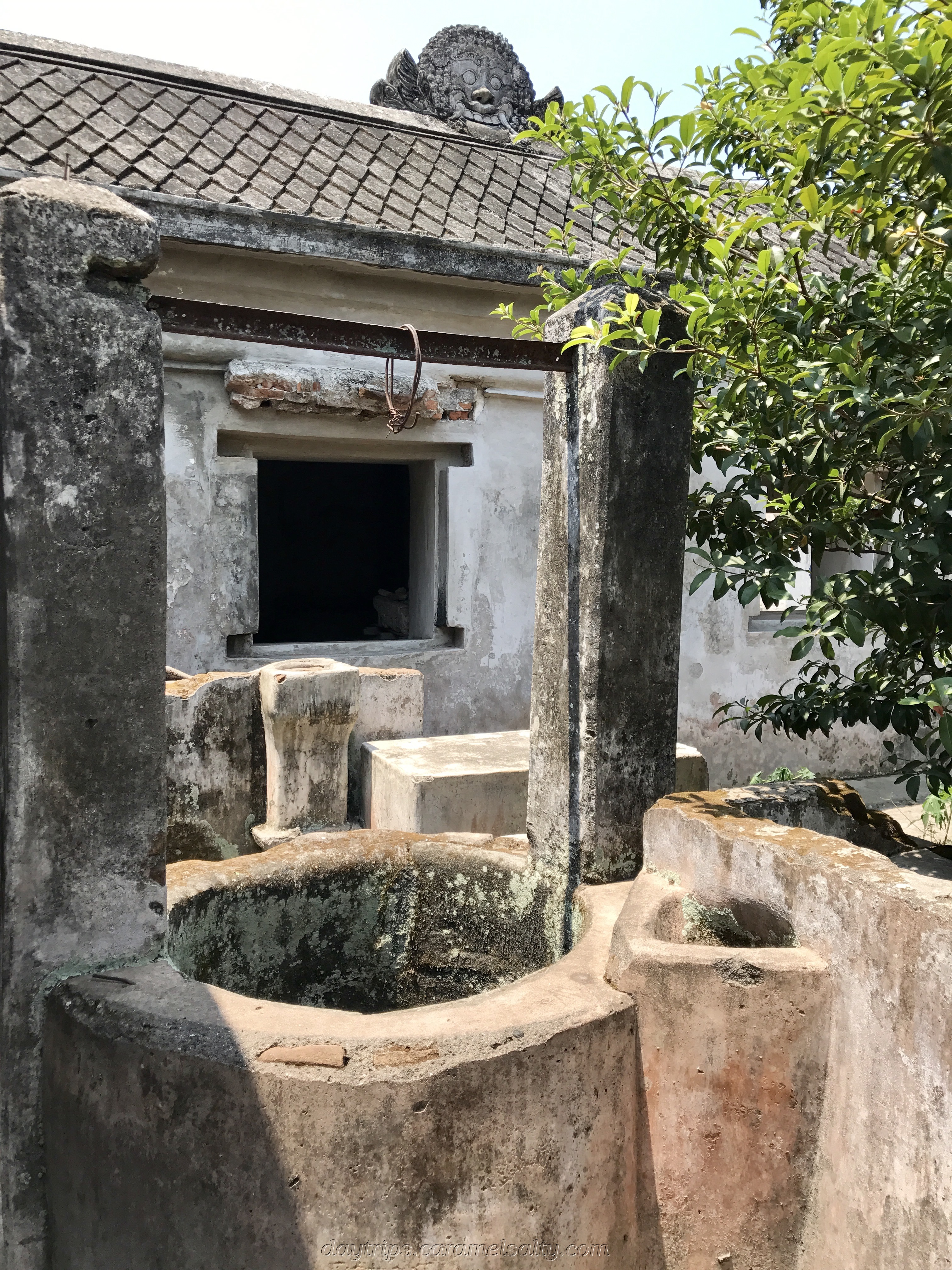 of the Sultanate of Yogyakarta. The pamphlet with the ticket describes various gedungs. However no map is provided. By chance, as I stood in the exit courtyard devouring my ice cream, I saw a group disappear down a stairwell. So I followed, and managed to discover three of the gedungs listed in the pamphlet. So don’t do what the other tourists do and only wander round the bathing place. There is more to this place than meets the eye.
of the Sultanate of Yogyakarta. The pamphlet with the ticket describes various gedungs. However no map is provided. By chance, as I stood in the exit courtyard devouring my ice cream, I saw a group disappear down a stairwell. So I followed, and managed to discover three of the gedungs listed in the pamphlet. So don’t do what the other tourists do and only wander round the bathing place. There is more to this place than meets the eye.
Alun Alun Kidul ⭐️
Head towards the Alun Alun south of the Kraton. You will see two banyan trees in the centre. One of the folklores linked with the Alun Alun Kidul is masangin, the ritual of walking through the twin banyan trees blindfolded. It is believed that those having pure hearts can walk directly through the two sacred trees. As soon as darkness descends on the square, it fills with crowds, light and music. You will see attempts at the masangin at this time.
Late Lunch – Gudeg⭐️⭐️⭐️⭐️
 Jalan Wijilan, near the Kraton, specialises in gudeg. Gudeg is the most famous dish in Yogyakarta, even making it a moniker City of Gudeg. This unique Indonesian dish is a stew made from young jackfruit (nangka) with palm sugar, coconut milk, meat, garlic, and spices. The special taste comes from the slow melding of flavours and textures to the right perfection. I had mine at Gudeg Yu Djum, which I would not recommend. They are a chain, and I found the restaurant dark, the service impersonal and the gudeg not spicy. So I would suggest trying one of the others or asking around for the best gudeg in town.
Jalan Wijilan, near the Kraton, specialises in gudeg. Gudeg is the most famous dish in Yogyakarta, even making it a moniker City of Gudeg. This unique Indonesian dish is a stew made from young jackfruit (nangka) with palm sugar, coconut milk, meat, garlic, and spices. The special taste comes from the slow melding of flavours and textures to the right perfection. I had mine at Gudeg Yu Djum, which I would not recommend. They are a chain, and I found the restaurant dark, the service impersonal and the gudeg not spicy. So I would suggest trying one of the others or asking around for the best gudeg in town.
Museum Affandi ⭐️⭐️⭐️[Opening Hours: 09:00-16:00]
On the bank of the Gajah Wong River on Solo Street, the painter Affandi designed and constructed his home, which now functions as a museum to display his and his  family’s paintings (his children are also artists in their own right). The building is uniquely constructed, with a roof that resembles a banana leaf. The museum has around 250 of Affandi’s paintings. Affandi and his first wife are buried in the museum grounds.
family’s paintings (his children are also artists in their own right). The building is uniquely constructed, with a roof that resembles a banana leaf. The museum has around 250 of Affandi’s paintings. Affandi and his first wife are buried in the museum grounds.
I found the museum humid and hot. However there is an interesting video about Affandi of him painting. I found his abstract art fascinating. Buses that head towards the airport/Prambanan will drop you off nearby.
Street Art at Stadion Kridosono ⭐️⭐️⭐️
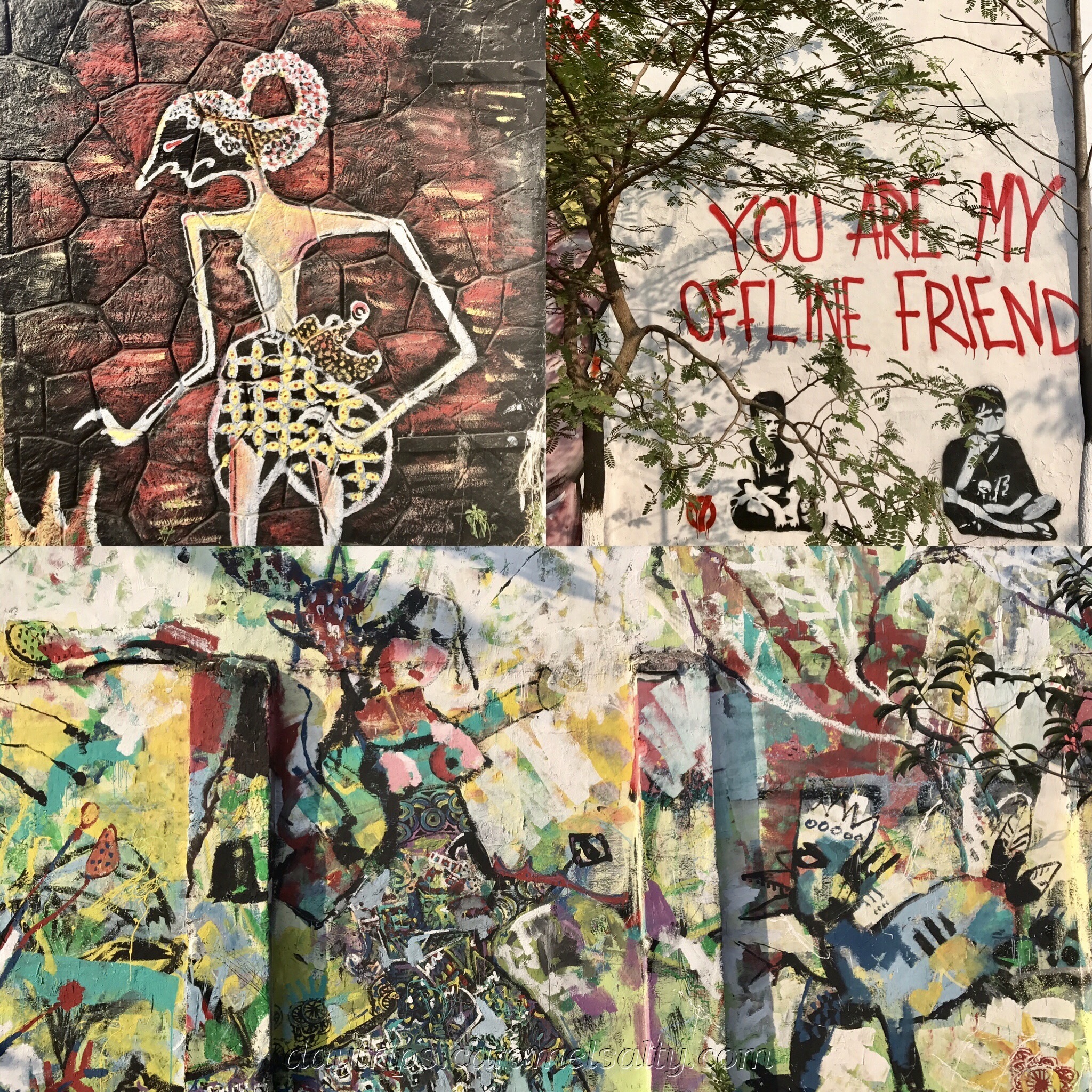 If it’s still light you should get down to Stadion Kridosono. The walls of
If it’s still light you should get down to Stadion Kridosono. The walls of 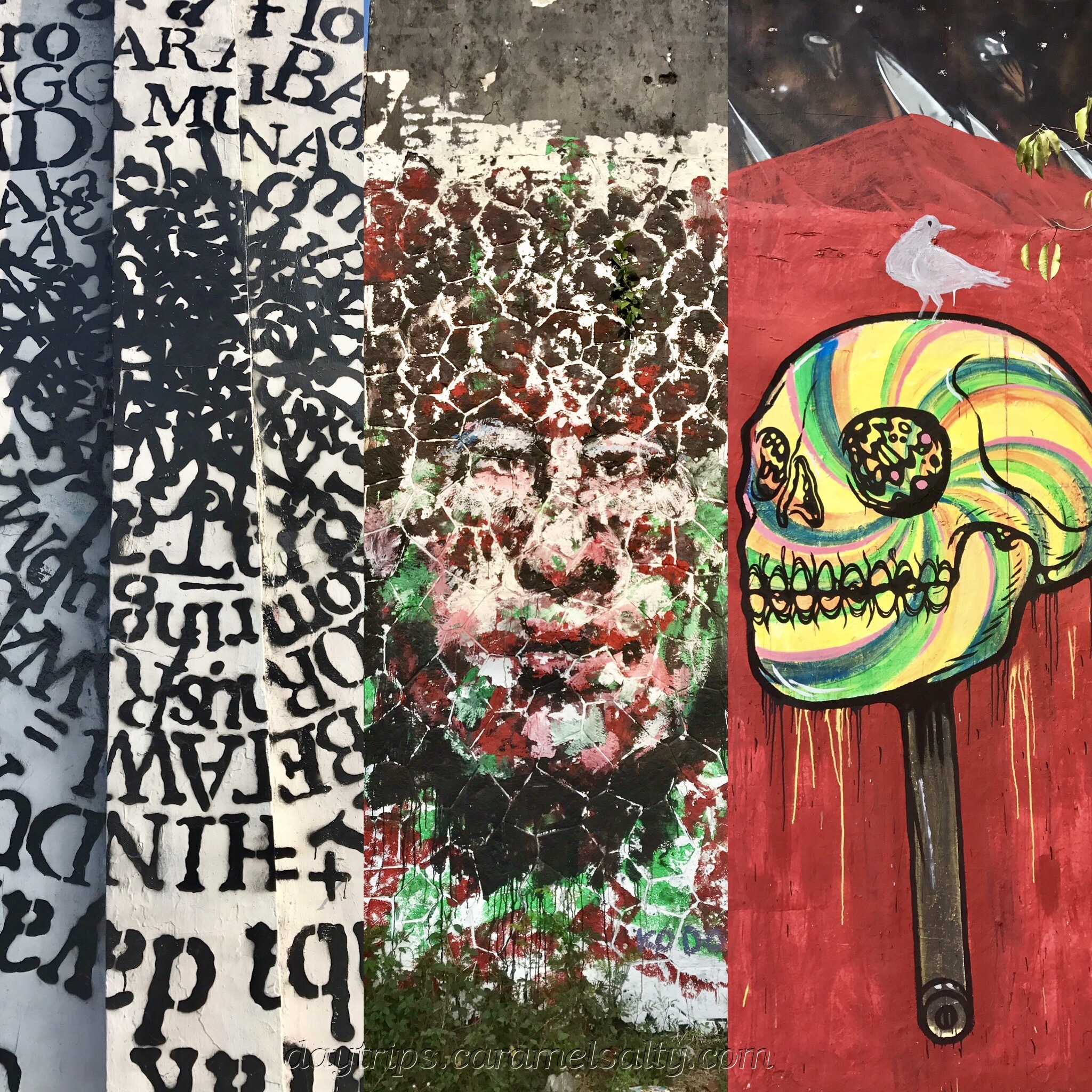 the stadium are covered in magnificent street art. I walked it in 15 minutes from the train station. The roads around it are busy. May be a better option to do this very early in the morning instead.
the stadium are covered in magnificent street art. I walked it in 15 minutes from the train station. The roads around it are busy. May be a better option to do this very early in the morning instead.
Evening Activities
Dinner or Supper – Angkringan and Kopi Joss ⭐️⭐️⭐️⭐️⭐️ [from midday to early hours of the morning]
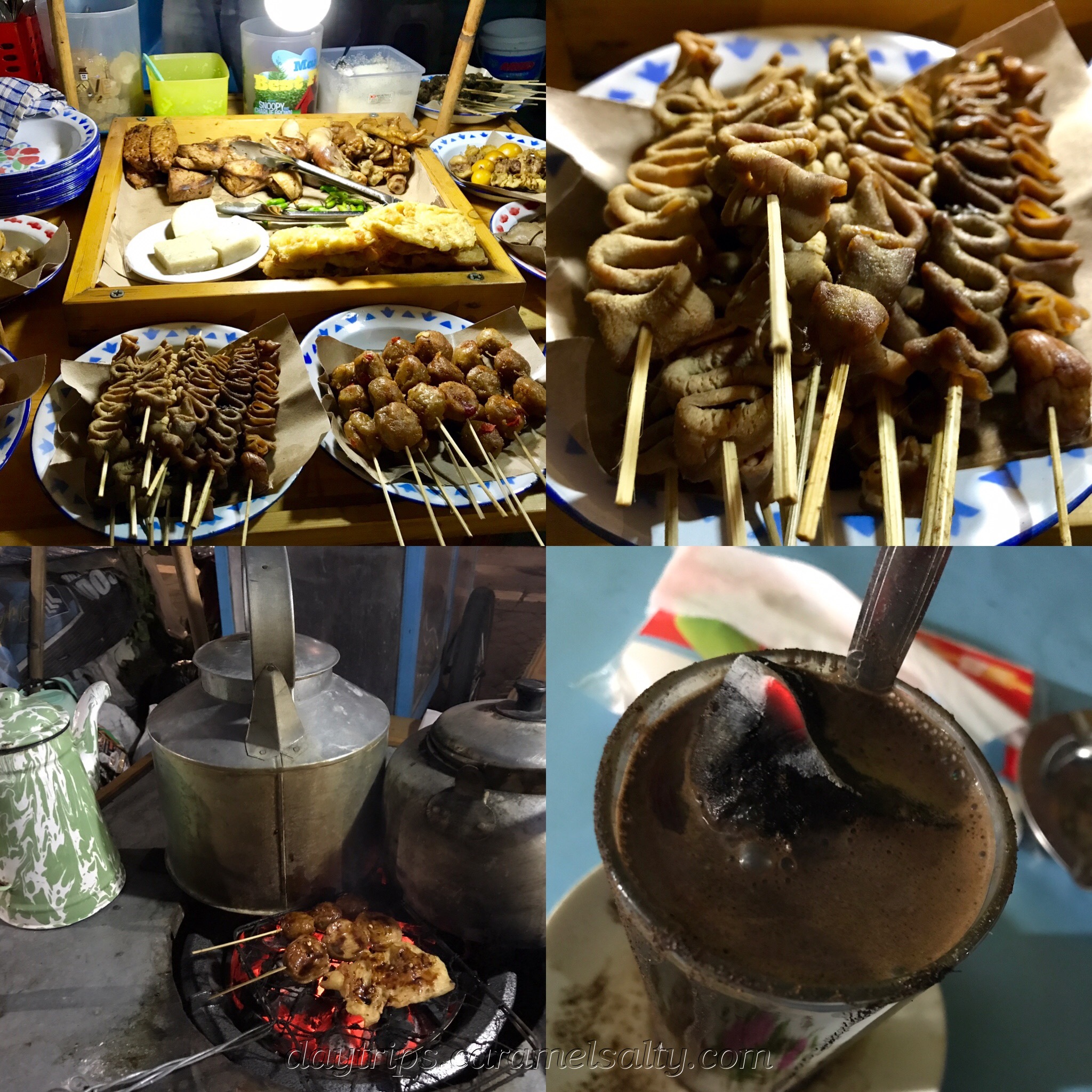 All along Jalan Malioboro, north of the train station, are Ankringan and Kopi Joss stalls. Kopi Joss is coffee with a bit of burning charcoal in it. Unusual, but doesn’t taste too bad. These stalls also sell Nasi Kucing (Cat Rice) that consists of a small serving of rice with a sambal. And then there is bakso (fish or chicken balls), tempeh, chicken liver, feet and intestines which are
All along Jalan Malioboro, north of the train station, are Ankringan and Kopi Joss stalls. Kopi Joss is coffee with a bit of burning charcoal in it. Unusual, but doesn’t taste too bad. These stalls also sell Nasi Kucing (Cat Rice) that consists of a small serving of rice with a sambal. And then there is bakso (fish or chicken balls), tempeh, chicken liver, feet and intestines which are all barbecued on sight. It was my favourite meal in Jogjakarta. And if you are game, try dining the local way, which is to sit on mats laid out on the ground. I finished off the meal with a Wedung Uweh. It’s a jamu (herbal drink) and is described on Wikipedia as a drink with vegetation resembling rubbish. Mind you, the herbs did look like dried leaves and twigs.
all barbecued on sight. It was my favourite meal in Jogjakarta. And if you are game, try dining the local way, which is to sit on mats laid out on the ground. I finished off the meal with a Wedung Uweh. It’s a jamu (herbal drink) and is described on Wikipedia as a drink with vegetation resembling rubbish. Mind you, the herbs did look like dried leaves and twigs.
Shop at Jalan Malioboro and Pasar Beringharjo⭐️⭐️⭐️
At the streets of Malioboro and at the Beringharjo market, you will find lots of stalls selling anything you can think of from batik, to bags to rattan products and silver jewelrey, food and anything you thought you might find in Indonesia.
Kakiku Massage Centre ⭐️⭐️⭐️ [Opening Hours:11:00 to 03:00]
You could even finish the night off with a head and foot massaage at Kakiku. They are open till the early hours, although there is a small premium of Rp10,000 to pay for appointments after 20:00.
Other Places for Meals⭐️⭐️⭐️⭐️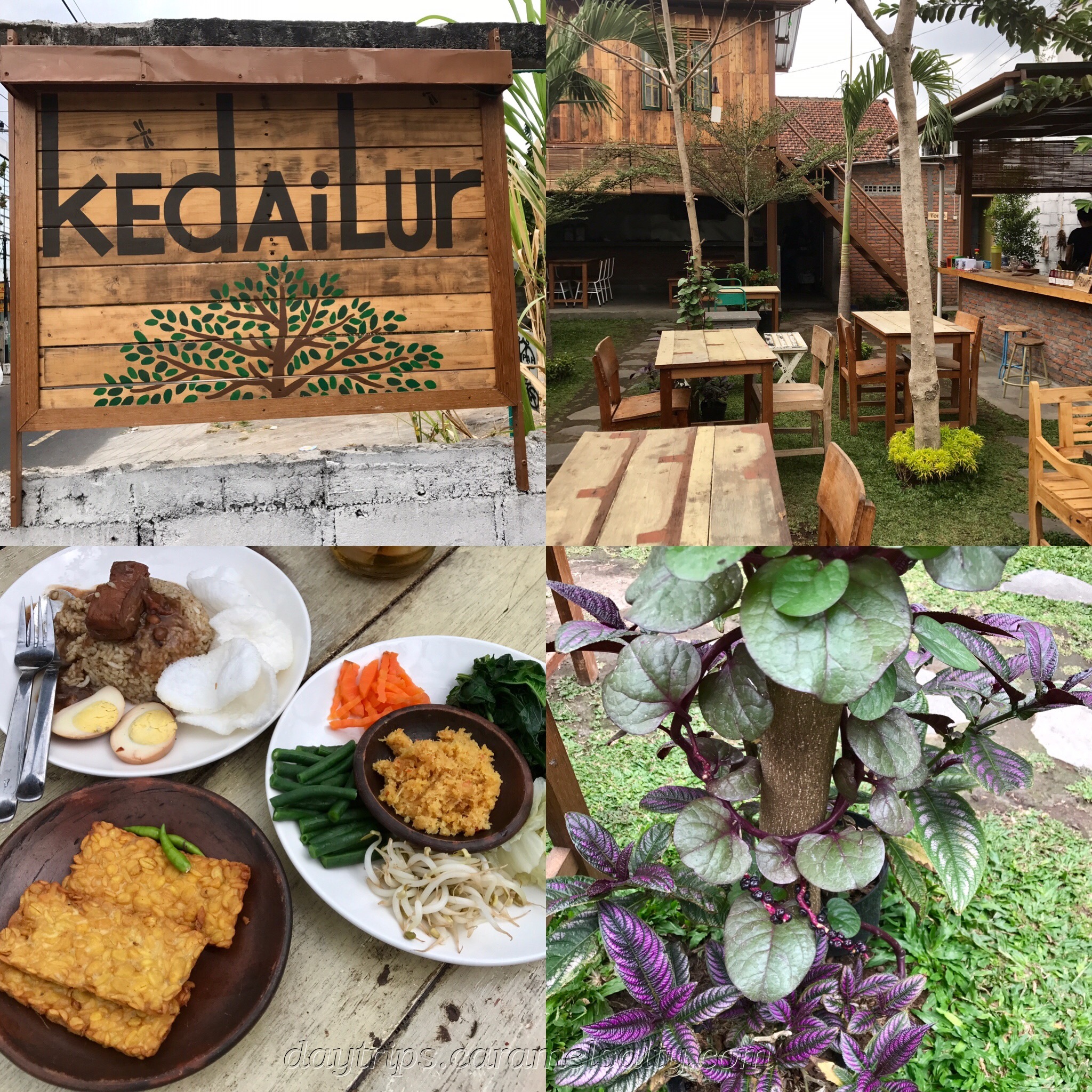
Kedailur- lovely outdoor venue on Jalan Gowongan Kidul. Opening Times are from 10:00 to 22:00. They do a good mi goreng ayam (fried mee with chicken).
Day 4 -Kaliurang
Ullen Sentalu Museum⭐️⭐️⭐️ [Opening Hours: 08:30 – 17:00]
The Ullen Sentalu website does suggest that its possible to get there by public transport. The instructions are in Indonesian. So here is the translation. Catch Bus TransJogja 2B or 3B and get off at the Shelter Ring Road 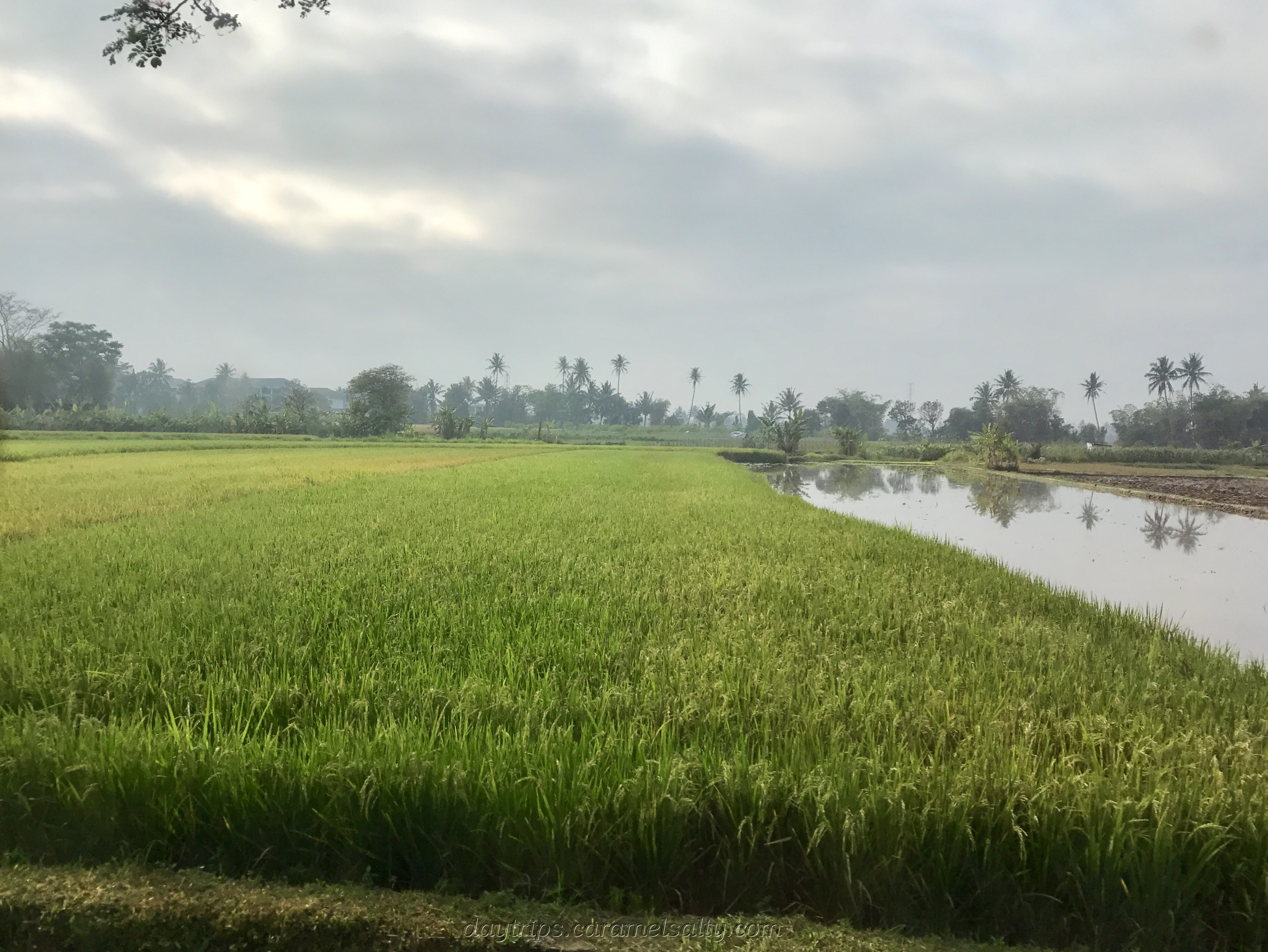 Utara-Kentungan stop. Walk back to the North-South road and flag the Yogyakarta – Pakem bus (angkot) from the road side (there is no such thing as bus stops any longer) and get down at the Pakem Market (Pasar Pakem). Transfer to the angkot for Pakem-Kaliurang and get down at the Children’s Playground (Taman Kanak-Kanak Kaliurang). Walk west about 300 meters. The website does suggest that the buses to Kaliurang are sporadic and stop running by 14:00. In my case, I could not find a bus back and so had to walk the 5 miles back to Pakem. I could have also probably hitched a ride on the many motorbikes going to Pakem. However the journey up there is worth the views of paddy fields and of Gunung Merapi, which is still an active volcano.
Utara-Kentungan stop. Walk back to the North-South road and flag the Yogyakarta – Pakem bus (angkot) from the road side (there is no such thing as bus stops any longer) and get down at the Pakem Market (Pasar Pakem). Transfer to the angkot for Pakem-Kaliurang and get down at the Children’s Playground (Taman Kanak-Kanak Kaliurang). Walk west about 300 meters. The website does suggest that the buses to Kaliurang are sporadic and stop running by 14:00. In my case, I could not find a bus back and so had to walk the 5 miles back to Pakem. I could have also probably hitched a ride on the many motorbikes going to Pakem. However the journey up there is worth the views of paddy fields and of Gunung Merapi, which is still an active volcano.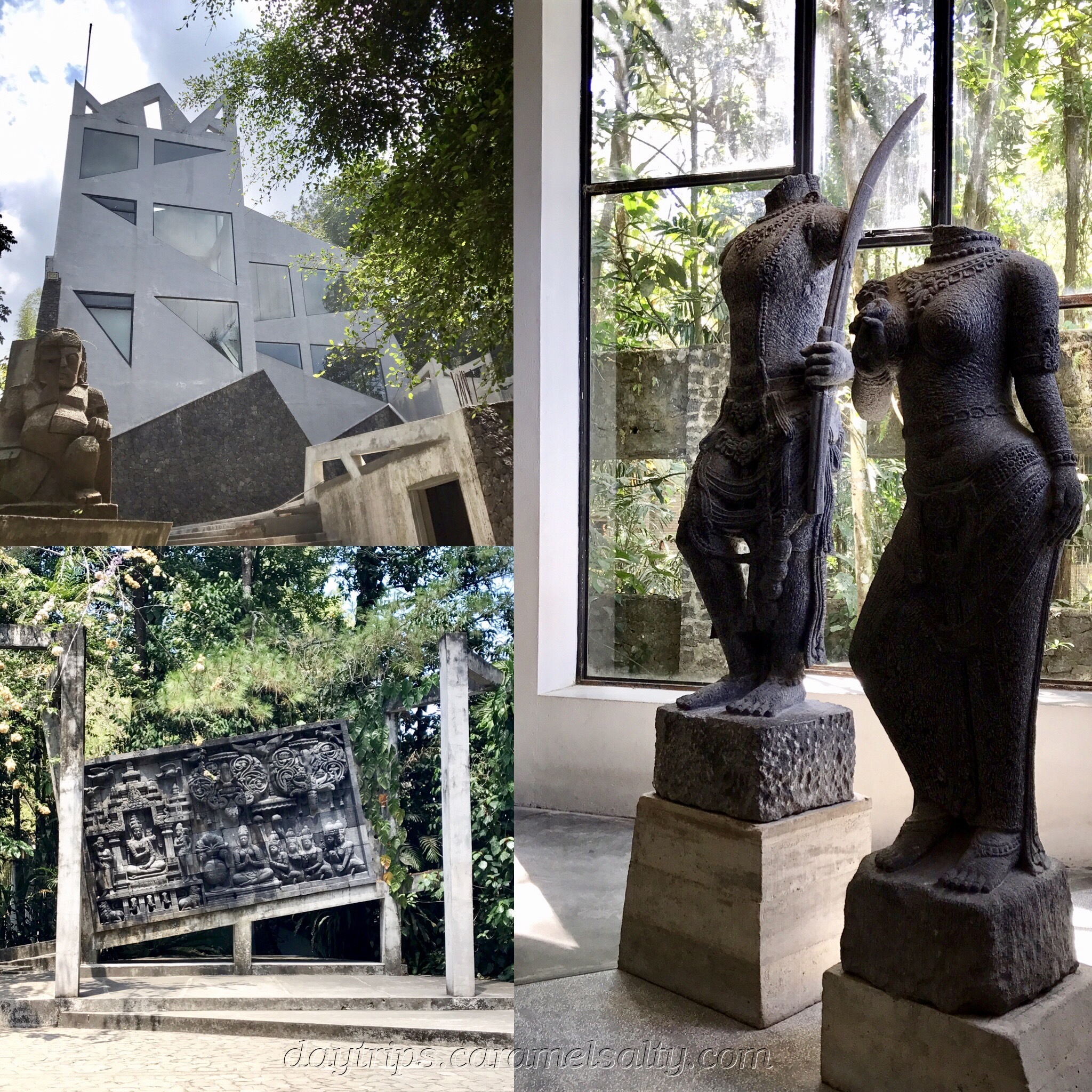
Ullen Sentalu is a private museum which is still undergoing expansion. The price of the ticket includes a guided tour of the history of the royal families of Jogjakarta and Solo, the only surviving sultanate in Jawa. It also has a cafe overlooking beautiful gardens.
I LEAVE JOGJA AFTER 4 DAYS
I think I’ve only discovered the tip of the iceberg in Jogja. Taman Sari and the nearby Cyber city are warrens of streets waiting to be discovered. There are also more candis around Prambanan that I did not manage to get to. And batik courses to attend. And Solo, which can be visited as a day trip by bus or train.
Only 2 days in Jogja? No way!! Even with 4 days, I had run out of time to discover everything I wanted to. I will be back.